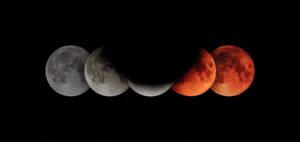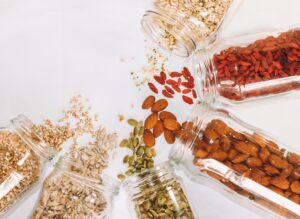Beth Rush
‘Moon eating’ may sound like living on a steady diet of that astronaut ice cream museum gift shops often sell. However, it has nothing to do with consuming the same meals as someone aboard the space shuttle. Rather, the lunar diet concerns itself with balancing your hormones and achieving optimal health by tuning into your body’s natural cycles.
Like any meal plan, the lunar diet has lists of foods to indulge in and avoid. However, it doesn’t base their recommendations solely on calories in, calories out. Instead, it focuses on what a woman needs for nutritional support as she goes through her menstrual phases. It shares a lot in common with seed cycling but goes beyond that practice.
If you suspect hormonal imbalances contribute to your health woes, or if you repeatedly gain and lose a similar amount of weight each month, this plan may be for you. Here’s how to use a lunar calendar for general good health.
Why You Should Try the Lunar Diet
Foods on the lunar diet benefit people who struggle with issues like hormonal acne, anxiety, and depression
Why should you try the lunar diet? One reason is that your hormones impact far more than your fertility and menstrual cycle. For example, women with a thyroid imbalance often experience debilitating fatigue that interferes with their daily functioning. It’s pretty tough to put in a productive workday when you feel like you can barely lift your head off your pillow.

What do thyroid imbalances have to do with the lunar diet and your cycles? Quite a bit. Your hormones engage in a delicate dance with each one affecting the other. Women with thyroid dysfunction often experience similar disruptions in sex hormone levels, affecting everything from their periods to their desire for intimate relationships.
Fortunately, that’s also why so many foods on the lunar diet benefit people who struggle with issues like hormonal acne, anxiety, and depression. Although you may target specific systems, your body works more holistically; essentially, what benefits part of the endocrine system creates a ripple effect that improves the entire works.
What Should You Eat and Avoid on the Lunar Diet?
Are you considering giving the moon diet a try? Fortunately, you don’t have to worry about calorie counting or restriction. Step one is to limit the amount of problematic food you consume and up your intake of healthier versions. Step two is coordinating specific items with their corresponding time of when is good to consume them in your menstrual cycle.
In general, you should strive to get more of the following foods in your diet:
1. Seafood
Seafood is rich in omega-3 fatty acids. Maintaining the right balance of omega-3s to omega-6s is essential to optimal health, including in your endocrine system. Many experts consider the ideal balance to be somewhere between 3/1 and 4/1. However, the typical western diet is closer to 16.7/1, causing significant health risks. For example, women with a lower omega-3 to omega-6 ratio had a decreased risk of breast cancer.
2. Deep, Leafy Greens
Remember Popeye and his spinach? Deep, leafy greens are an excellent plant-based iron source. Many women lose this nutrient when they bleed once a month, perhaps contributing to the fatigue some experience with their ‘moon time’ (or menstrual period). Additionally, these foods provide nutrients like A, D, E and K. They’re also chock-full of B-vitamins, essential for expectant and nursing mothers.
3. Nuts and Seeds
Fans of seed cycling shouldn’t be surprised to see these items on the list. Seeds in particular are excellent sources of lignans, proteins that have a marked effect on female reproductive health. For example, the lignans in flaxseeds can alter estrogen metabolism.

Nuts and seeds are also rich sources of magnesium, selenium and zinc. These nutrients play pivotal roles in brain health and may help stave off some of the moodiness spurred by hormonal changes.
4. Brightly Colored Vegetables
Brightly-colored vegetables are a huge source of various phytonutrients, which play multiple roles in nurturing health. For example, yellow and orange veggies have high beta-carotene levels, a substance your body converts to vitamin A, which helps protect cells against damaging free radicals. The more variety you get the better. Therefore, strive to eat a rainbow — include at least three colors on your plate at every meal.
5. Soy
Those who are estrogen-dominant may avoid soy as it contains phytoestrogens that mimic the role of estrogen in the body – over consumption leads to estrogen-dominance. Surprisingly, research has found that soy can act as an anti-estrogen in pre-menopausal women because of the amount of the hormone they already have circulating. Consumption seems to tell their physiology to put on the brakes, and the hormonal form you get from the plant is weaker than that your body produces. However, it can act like an estrogen in post-menopausal women, perhaps reducing cancer risk in some.
Pay attention to your consumption of foods high in omega-6
Additionally, here are some foods you should avoid on the moon diet:
- Foods with ultra-processed flour: White flour is a hormonal nightmare for two reasons, both starting with insulin. Your pancreas makes this essential hormone. All-purpose flour manufacturers remove the nutrient-rich bran and chaff, leaving a quickly absorbing substance that spikes your blood glucose, pressuring insulin reserves. Furthermore, alloxan, a chemical byproduct, destroys your pancreas, making this stuff a recipe for Type 2 diabetes.
- Sugar, especially added sugars: Sugar absorbs quickly, causing the same blood sugar problems as white flour. Fruits contain high sugar levels but also plenty of fiber that slows absorption. However, additives like high fructose corn syrup go right to your bloodstream.
- Salt: Salt contributes to fluid retention, making the bloating that often accompanies hormonal shifts worse.
Finally, you should pay attention to your consumption of foods high in omega-6 fatty acids on the moon diet, such as those laden with various plant-based oils like corn, canola, safflower and sunflower.
How can you best design your lunar diet meal plan?
The answer is as individualised as you — but most share specific characteristics. To design your lunar calendar for optimal health, you have to first differentiate between the different stages of your cycle:
- The follicular stage: This occurs before you release an egg, and starts from the first day of your last menstrual period. During this period, estrogen predominates.
- The ovulation stage: During this stage, which occurs between day 11 and 14 of your cycle for most women, you release an egg. Some women experience bloating and abdominal pain known as mittelschmerz during this time as progesterone levels increase.
- The luteal phase: This final stage lasts from ovulation to your next menstrual period. Progesterone remains high but wanes as time progresses without pregnancy, leading to menstruation.
You should keep the following in mind when designing your lunar calendar.
1. During the Follicular Stage:
Your estrogen levels remain high during this stage. Therefore, those with estrogen dominance may experiment with increasing their soy consumption to see if the phytoestrogenic compounds balance out your body.
avoid alcohol during this phase
Furthermore, you should avoid sugar and white flour the most during this stage. Why? Sugar consumption can increase estrogen levels, delaying ovulation, messing with fertility, and increasing adverse symptoms when you do release an egg.
Pro-tip: Avoid alcohol during this phase, too. While this substance causes an initial blood sugar spike, it’s followed by a drop that can mess with your hormones.
2. During Ovulation
Ovulation lasts only a day or two. However, it is best to avoid excess salt during this time. You may crave it — but it can exacerbate bloating and discomfort. Instead of sticking with the RDA of 2,300 milligrams, try to stay within the American Heart Association limits of 1,500 milligrams.
3. During the Luteal Phase
Here’s where you want to go a bit nutty. The minerals in nuts will help to support the mood changes that can occur as your period approaches. Furthermore, the lignans in seeds help to balance female hormones and ease the estrogen dominance that can lead to heavy periods.
Guess what else is good for boosting your progesterone levels after you ovulate? Chocolate. That’s right — there’s a scientific reason you crave it this time of the month as your levels begin dropping.
Lunar Eating: How to Use a Lunar Calendar for Optimal Health
If you suspect you could benefit from the lunar diet to solve your hormonal weight gain or simply achieve a more balanced lifestyle, why not give the moon diet a try? You have can only improve your overall health.
Now that you know how to design your lunar calendar, get started on your plan. Observe how you feel over the next five or six menstrual cycles and stick with the program to achieve lasting relief.
Featured image courtesy of Zoltan Tasi on Unsplash. No changes were made to this image. Image license can be found here.

